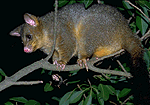Common brushtail possum

Common name: common brushtail possum
Scientific name: Trichosurus vulpecula
Family: Phalangeridae
Conservation status: This species is listed as Least Concern in Queensland (Nature Conservation Act 1992).
Description
The common brushtail possum is the most familiar and abundant of the Australian possums. It is a large possum with a bushy tail and pointy ears. Usually silvery grey in colour with a black band across the snout, they have a white to brownish-yellow belly. Adults can weigh around 1.5-4 kg. The combined head and body length is between 35 and 55 cm and tail length is 25-40 cm.
Habitat and distribution
Common brushtail possums are found in many types of habitats, they live in wooded areas along Australia's east coast, eastern South Australia and south-west Western Australia. They have adapted well to living with humans and are commonly encountered in urban areas, suburban backyards, campgrounds and sometimes the ceilings of houses.
Life history and behaviour
Brushtail possums are nocturnal animals, coming out after dark to feed on flowers, fruit, buds and leaves of native plants. Mistletoe, one of their snacks, is a parasite that can kill gum trees, the common brushtail possum helps to protect gum trees by controlling the mistletoe. Insects, eggs and meat may also be eaten infrequently. In suburban areas the species may become an opportunistic feeder eating almost anything that it can find. They spend their days in a den in a hollow dead branch, tree trunk, fallen log or even on the ground.
Communication is by sound and scent. Deep guttural coughs and sharp hisses are frequent forms of communication, particularly in the breeding season. You may sometimes hear this sound as they scamper across your roof at night when they move between feeding areas.
The common brushtail possum breeds throughout the year, with the majority of births occurring between March and November. Females reach sexual maturity of approximately one year and males in their second year. Adult female possums have a large, forward facing pouch.
A single furless young is born after a 17.5 day gestation, weighing 200 mg and measuring approximately 15 mm. The young makes it way from the birth canal to the large forward facing pouch where it will attach itself and suckle from one of two teats. It makes its first pouch exit at around 121 days and permanently leaves the pouch at around 150 days.
Problems with possums?
People regularly report problems with possums crawling into their roofs. Possums often move into roof cavities looking for a safe, dry place to sleep during the day before venturing out at night in search of food. If a possum in your roof is causing problems there are a number of things you can do to possum-proof your house.
Injured possums
If you encounter sick, injured or orphaned wildlife (including possums) immediately call 1300 ANIMAL (1300 264 625) to give the animal the best chance of survival.
Further information
Menkhorst, P and Knight, F 2001. A field guide to mammals of Australia. Oxford University Press, Melbourne, Victoria.
Strahan, R 1983. The Australian Museum complete book of Australian mammals. Angus and Robertson Publishers, Sydney, New South Wales.
Listen
Listen to an audio clip of the brushtail possum.
† Requires an appropriate media player